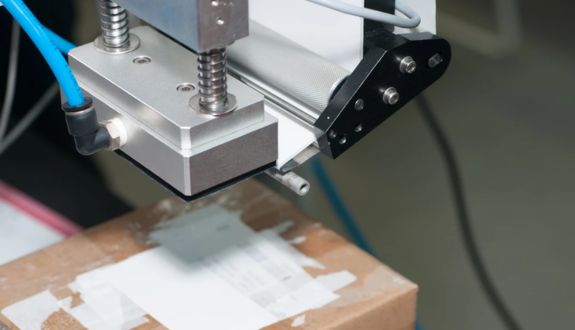Print and apply is an automated process that enables a shipping label to be printed in real-time and directly applied to a box or carton before it is sent down the line for distribution. The label is printed with a barcode that’s specific to a certain carrier (USPS, FedEx, UPS, e.g.), as well as other information, such as the recipient’s address.
Print and apply is made possible by a warehouse execution system (WES) that can uniquely identify each box, print the appropriate label, and then automatically adhere the label to the box. In high-volume, high-efficiency warehouses, the print and apply process also includes automated taping of the boxes. If a taping machine is not included, operators tape the boxes manually.
Even small to medium sized distributors must seriously consider a print-and-apply solution. The Return on Investment in a properly configured and integrated solution will typically realizes a jaw dropping return on the investment.
A warehouse management system (WMS) or a warehouse execution system (WES) contains the data needed to ensure customer orders are fulfilled accurately. These systems identify each carton or box—typically, with a barcode label—from the first moment goods are placed into it. That unique identifier is used later in verification processes and then ultimately, in print and apply. The print and apply system can read the barcode and then print the appropriate label, complete with carrier information and the recipient’s address. Then, the box can continue on the conveyance system for sortation to the appropriate carrier lane or dock and then shipping.
The business benefits of print and apply
In today’s complex eCommerce distribution environments, print and apply improves performance and accuracy by significantly reducing or eliminating manual operations. With print and apply, shipping labels are automatically printed and adhered to boxes, and then the box is sent down the line to shipping. That means operators do not have to manually scan barcodes or handle the boxes or labels. In many facilities, the print and apply process also includes taping machines, so that taping can be done automatically without human intervention. These automatic computer-driven processes save time and reduce errors introduced by manual steps.
Determining the ROI of print and apply
Replacing manual operations with an automated print and apply system can deliver significant return on investment (ROI)—particularly for warehouses that process hundreds or thousands of cartons per hour. Keep in mind that in addition to the system itself, a print and apply solution requires infrastructure, such as a warehouse management system (WMS) or warehouse execution system (WES), as well as a conveyor system that is sophisticated enough to support the technology used in a print and apply tunnel. All of these components function outside of an enterprise resource planning (ERP) system, and all of them must be integrated to ensure that print and apply processes are as efficient and accurate as possible.

No. All warehouse management systems (WMS) do not support print and apply. That is why it is critical to find a WMS vendor that can provide not only a WMS, but also a warehouse execution system (WES) or warehouse control system (WCS) capabilities that meet your needs. WES and WCS are important because they offer direct communication with print and apply devices—and with the conveyor system that keeps the entire process moving.
It may be helpful to think about the WMS as the “brain” and the WES or WCS as the “nervous system” that carries out the commands sent by the brain. Any communication between these systems must be direct, and it must be in real-time. That is the only way cartons can be conveyed, verified, and labeled at high speed. All of these steps must require synchronization and integration between the WMS and WES / WCS.
The disadvantages of standalone print and apply devices
Standalone print and apply devices are available; however, since these devices are not integrated with a WMS, they cannot provide the real-time response rates required for efficiency and often require manual intervention to operator. As a result, they tend to introduce inaccuracy and lag in print and apply processes. These kinds of risks multiply every time another standalone system is introduced to warehouse operations.
For example, if there is one kind of standalone system for automated storage, a different one for the conveyor, and yet another one for print and apply, the integrations are so complex that they are likely to fail or at a minimum require a much higher cost of ownership. At the very least, this arrangement makes maintenance and support very difficult. Remember, an enterprise resource planning (ERP) system functions at the order level. Then, the warehouse management system (WMS) knows where to actually find those goods and get the order fulfilled. A warehouse execution system (WES) or a warehouse control system (WCS) are the actual pieces of the puzzle that execute the commands of the WMS. They make it possible to find the goods that have been ordered, place them in cartons, positively identify them, and actually convey them through to shipping.
